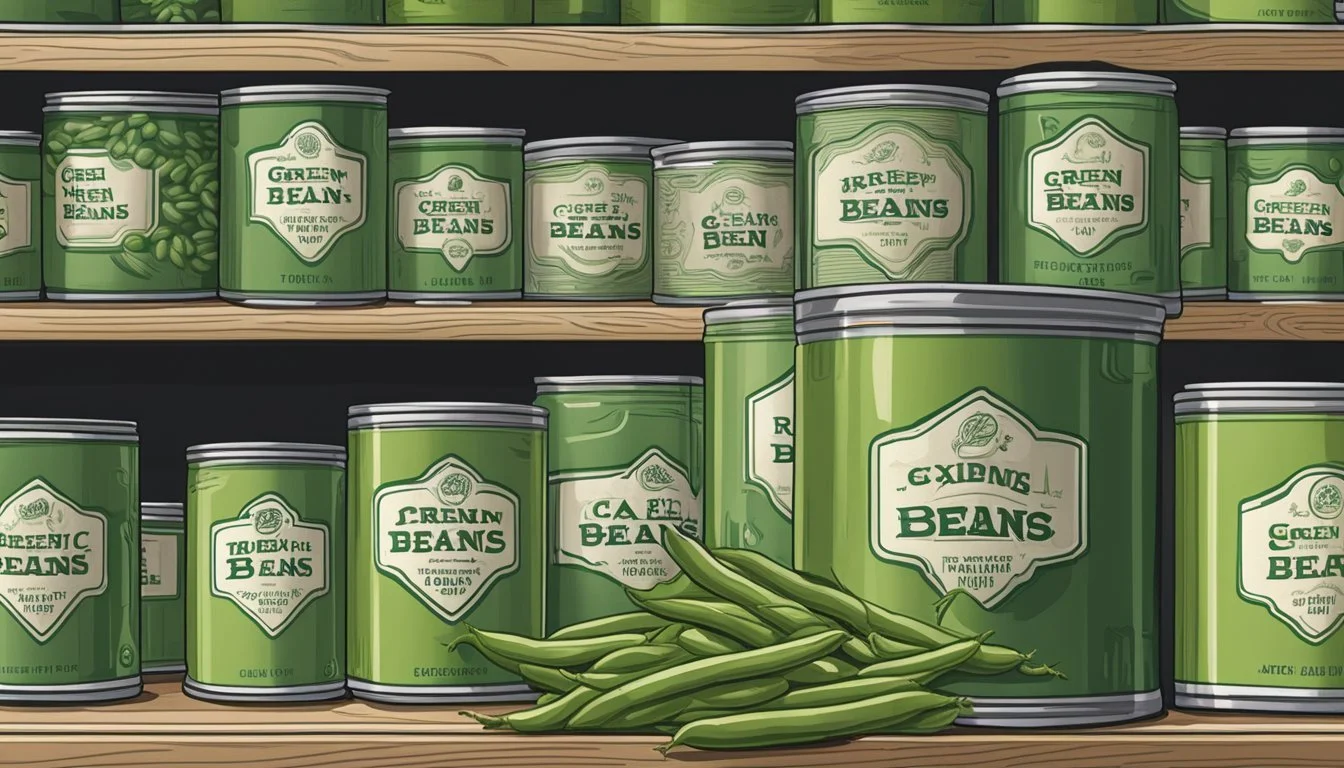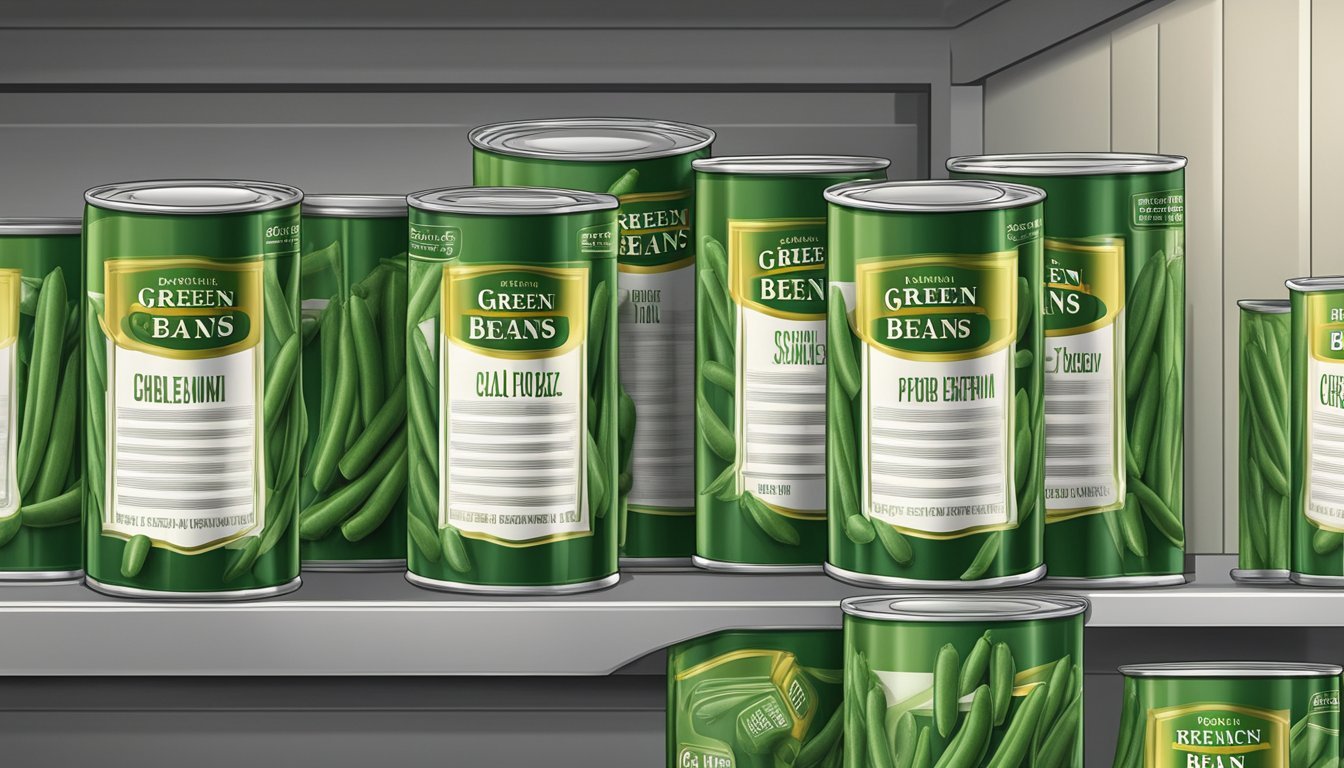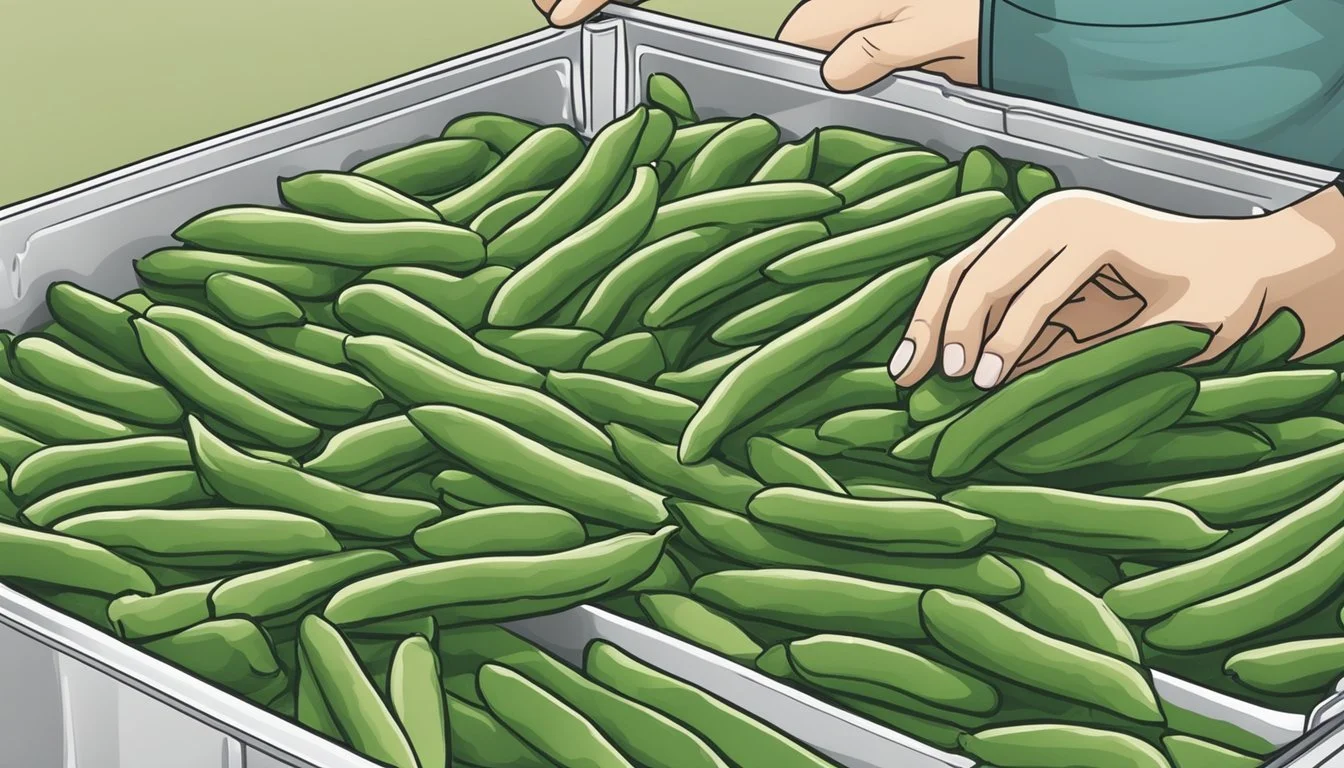Do Canned Green Beans Expire?
Shelf Life and Storage Tips
Canned green beans are a versatile and convenient pantry staple found in many households. While they do come with an expiration date, this date is more about peak quality rather than safety. Canned green beans, when stored in a cool, dry place, can remain edible for years beyond this indicated date.
The shelf life of canned green beans largely depends on how they are stored. Proper storage can extend their quality and flavor for about two to five years past the printed expiration date. However, consumers should always examine the can for signs of spoilage, such as bulging lids or unusual odors, before use.
Understanding the longevity and storage requirements of canned green beans can help reduce food waste and ensure safety. These factors make canned green beans an economical and reliable option for many.
Understanding the Shelf Life of Canned Green Beans
Canned green beans have a long shelf life, which can be extended if stored properly. Many factors contribute to their longevity, including the date of manufacture and storage conditions.
Manufacturing Date and Expiration Date
Canned green beans typically have a "best-by" or "sell-by" date rather than a strict expiration date. This labeling informs consumers about the period during which the product will be at its peak quality. Properly stored, unopened cans often remain in good condition for 3 to 5 years beyond this date.
Manufacturers ensure the canning process preserves the beans by sealing them in airtight containers and subjecting them to high temperatures. These processes eliminate bacteria and enzymes that could spoil the food. This contributes to the extended shelf life that canned goods are known for, as long as the cans remain intact and undamaged.
Factors Affecting Shelf Life
Several factors can influence the shelf life of canned green beans. Storage conditions are paramount—cans should be kept in a cool, dry place away from direct sunlight and temperature fluctuations. Heat and humidity can accelerate spoilage, even in sealed containers.
Additionally, it's important to inspect cans for any signs of damage, such as bulging lids, rust, or dents. These could indicate compromised integrity, increasing the risk of bacterial contamination. If a can shows visible damage or emits a strange odor upon opening, it’s safer to discard it.
Transfer open canned green beans to airtight containers and refrigerate them to extend their usability. They can typically last up to 3-4 days when stored this way. Following these steps ensures that canned green beans remain safe and enjoyable to consume for an extended period.
Storage Recommendations for Canned Green Beans
To maintain the quality of canned green beans, certain storage practices must be followed. This includes keeping the beans in a proper environment and differentiating the storage needs of opened and unopened cans.
Proper Storage Environment
Canned green beans should be stored in a cool, dry place. Temperature plays a significant role in extending the shelf life. Ideally, cans should be kept at room temperature, between 50°F and 70°F (10°C and 21°C).
Avoid areas prone to extreme temperature fluctuations, such as garages or basements.
Humidity can also affect the cans, so storage areas should be dry. Excess moisture might cause rust on the cans, compromising their integrity and potentially leading to spoilage. Pantries and kitchen cabinets are often good storage spots if they are away from heat sources such as ovens or radiators.
Keep canned green beans away from direct sunlight. Ultraviolet light can cause the cans to degrade faster. Organize them in a way that the oldest cans are used first, adhering to a first-in, first-out method.
Opened vs. Unopened Cans
Unopened cans of green beans can last between 2 to 5 years when stored properly. After opening, they should be transferred to an airtight container and stored in the refrigerator. It is best to consume them within 3 to 4 days to ensure freshness and avoid bacterial growth.
Avoid storing opened green beans in their original cans. The metal can react with the air and contents, leading to a metallic taste. Transfer them to a glass or plastic airtight container to mitigate spoilage.
Label and date opened containers to keep track of freshness. Always inspect the contents for any signs of spoilage such as bad odor or mold before consumption.
Overall, maintaining proper storage practices significantly prolongs the shelf life and quality of canned green beans. Understanding the differences in storage requirements between opened and unopened cans ensures safety and better food quality.
Identifying Signs of Spoilage in Canned Green Beans
Detecting spoilage in canned green beans involves careful inspection of several indicators such as visual and textural changes, odor and taste examination, and checking for physical can damage.
Visual and Textural Changes
Spoiled canned green beans often display noticeable visual and textural alterations. Discoloration is a common sign; fresh green beans should be a vibrant green, while spoiled ones may turn brown or black. Keep an eye out for mold growth, which appears as fuzzy spots in different colors, typically white, green, or black.
Texture changes are also revealing. Canned green beans should remain relatively firm; if they are slimy, mushy, or overly soft, they may be spoiled. These textural changes indicate the breakdown of the beans' structural integrity due to bacterial or fungal activity.
Odor and Taste Examination
Odor is a crucial indicator of spoilage in canned green beans. Upon opening the can, take a moment to smell the contents. A foul or off-putting odor often signals that the beans have gone bad. Fresh canned green beans should have a mild, slightly salty aroma typical of preserved vegetables.
If the smell is questionable, proceed with caution to a taste test. Off flavors or sour taste are clear signs of spoilage. Canned beans that taste different from their usual flavor profile should not be consumed, as this could be indicative of chemical or bacterial contamination.
Physical Can Damage
Inspect the can itself for any signs of damage which could compromise the safety of its contents. A bulging can suggests gas production from bacterial activity inside, which is a strong indication of spoilage. Leaking cans, identified by moisture or liquid seeping out, can also point to contamination.
Rusting or severely dented cans should be avoided as these physical damages can weaken the can's structure, allowing bacteria to enter. Particularly, a severely dented can may have created tiny holes or cracks that let air and pathogens into the can, leading to potential spoilage.
Health and Safety Concerns
Canned green beans provide a convenient and long-lasting food option, but there are important health and safety considerations to keep in mind. Storage conditions, expiration dates, and the risk of contamination are key factors in ensuring they remain safe to eat.
The Risk of Foodborne Illness
Canned green beans can pose a risk of foodborne illness if not handled properly. Botulism is a severe concern, caused by the toxin from Clostridium botulinum bacteria. Symptoms include difficulty breathing, muscle paralysis, and can be fatal if untreated.
To ensure safety, check for signs of spoilage. Bulging lids, dents, or unusual odors are red flags. If any of these signs are present, discard the can immediately. Proper storage also minimizes risks. Store cans in a cool, dry place to extend shelf life.
Nutrient content may degrade over time, but properly stored canned green beans can retain many vitamins and minerals. Always prioritize food safety by inspecting cans and adhering to recommended storage practices.
Maximizing Quality and Nutritional Value
Ensuring optimal quality and nutritional value of canned green beans requires understanding how they compare to fresh and frozen options and the best practices for preserving quality after opening.
Nutritional Comparisons: Canned vs. Fresh vs. Frozen
When comparing canned, fresh, and frozen green beans, nutritional profiles vary. Fresh green beans typically contain the highest levels of vitamins and are rich in vitamin C and fiber.
Canned green beans, while convenient, often have added sodium to enhance flavor and extend shelf life.
Frozen green beans typically retain more nutrients than canned ones due to the rapid freezing process that locks in vitamins and minerals shortly after harvesting. For those concerned with sodium intake, it’s advisable to rinse canned green beans before consumption to reduce sodium content.
Preserving Quality After Opening
Once opened, canned green beans should be transferred to a different container to maintain freshness and prevent spoilage. Use an airtight container and store it in the refrigerator. Consume them within 3 to 4 days for the best quality.
To enhance their nutritional value, consider adding them to dishes with fresh vegetables or proteins. Proper storage and prompt consumption are key to maintaining texture and flavor.
Avoid leaving the beans in the can after opening as this can introduce bacteria and affect quality. By following these steps, one can maximize the nutritional benefits and maintain the desired quality of canned green beans.
Creative Use of Canned Green Beans in Recipes
Canned green beans can be surprisingly versatile in the kitchen. They can enhance classic recipes or inspire creative, new pairings that elevate everyday meals.
Classic Recipes and Dishes
Canned green beans are often featured in green bean casseroles. This dish includes common ingredients like cream of mushroom soup and French's fried onions, creating a hearty and comforting side.
They are also ideal for quick soups and stews, where they add texture and nutrients without much prep. Pairing green beans with meats such as ham or bacon can make simple dishes like soups and casseroles more flavorful.
In salads, canned green beans offer a crunchy texture and fresh taste, perfect when combined with elements like canned mandarin oranges and salad dressing.
Innovative Twists and Pairings
Think outside the traditional recipes to add excitement to your meals. Pan-seared canned green beans with garlic and cashews can transform a bland side into a crunchy, savory dish.
Another creative recipe is garlic Parmesan green beans, giving a cheesy twist to plain beans. Combine them with diverse ingredients like lemon juice, tarragon, or even salad oils for unique flavor profiles.
Tater tot casserole is another inventive use, mixing green beans with cheese and fried onions for a crowd-pleasing dish. These culinary experiments showcase how canned green beans can shine in everyday and extraordinary meals alike.
Tips on Properly Freezing Canned Green Beans
Freezing canned green beans can help extend their shelf life, but certain steps must be followed to ensure the best quality. Taking the time to properly prepare the beans will make a significant difference in their texture and flavor after freezing.
Preparation Steps Before Freezing
Begin by selecting canned green beans that have not yet expired. Drain the beans, removing any canning liquid as this may lead to a mushy texture after freezing. It's crucial to leave some headspace in the freezer-safe container since liquids can expand when frozen.
Consider blanching the beans by briefly heating them in boiling water for about 2-3 minutes before an ice bath. This process helps in retaining the beans' color and texture. Thoroughly dry the beans afterward using a clean kitchen towel or paper towels to prevent ice crystals from forming.
Optimal Freezing Techniques
Use freezer-safe containers or quality resealable plastic bags for storing the beans. Arrange the beans in a single layer on a baking sheet and freeze them until solid before transferring them to the containers. This method prevents the beans from clumping together.
Clearly label each container with the freezing date to keep track of storage time. While frozen canned green beans may last several months, using them within six months ensures the best quality. Maintaining a consistent freezer temperature of around 0°F (-18°C) is also essential for preserving the beans' texture and flavor.
The Canning Process and Its Impact on Shelf Life
The canning process, including both home and commercial methods, significantly influences the shelf life of canned green beans. This process involves critical steps like vacuum sealing and careful control of acidity to ensure long-term preservation.
Industry Standards for Canning Vegetables
Canned vegetables undergo stringent procedures to ensure their shelf life extends for several years. Commercially canned green beans are typically processed using an airtight vacuum seal that prevents the entry of bacteria and other microorganisms. The canning industry standards require the beans to be heated to a specific temperature for a determined period, effectively destroying bacteria and ensuring quality preservation.
Low-acid foods like green beans are especially susceptible to bacterial growth, requiring or recommended to be pressure-canned. This method achieves higher temperatures than boiling water canning, ensuring safety and longer shelf life.
The Chemistry Behind Preservation
The preservation of canned green beans hinges on the canning process's ability to create an environment inhospitable to spoilage organisms. The vacuum seal formed during canning removes oxygen, which is essential for bacterial growth. The heat applied during canning denatures enzymes and proteins in microorganisms, effectively eliminating the risk of foodborne illnesses.
Acidic and low-acid foods require different canning techniques. While low-acid foods, like green beans, need pressure canning, more acidic foods can be safely processed using boiling water canning. This distinction is critical because the type of food determines the processing time and temperature necessary for effective preservation.





